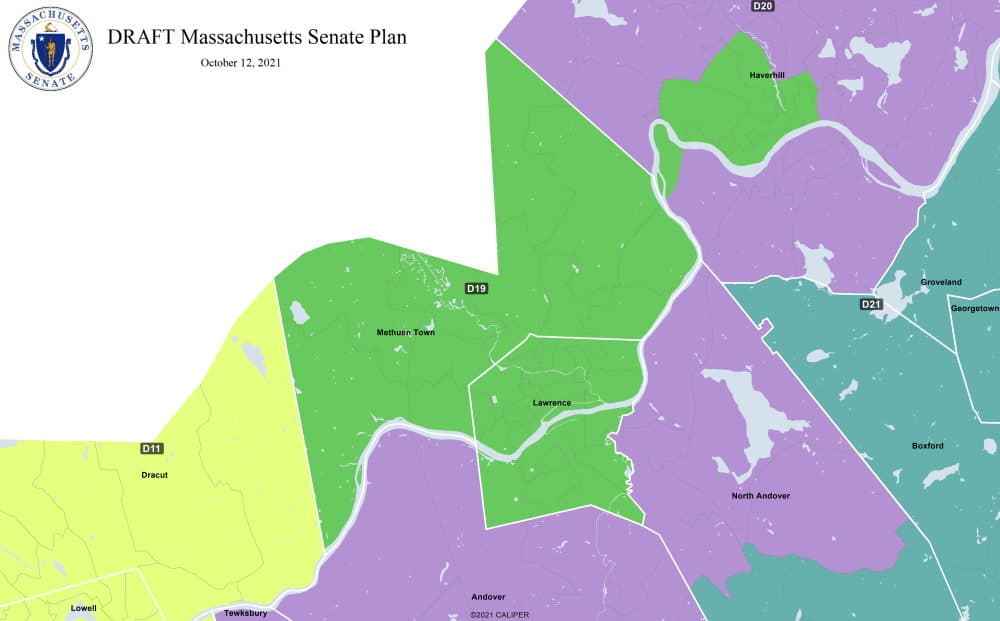Advertisement
Draft redistricting map by Senate special committee adds 2 majority-minority Senate districts

Massachusetts would add two new state Senate districts where non-white residents represent a majority of the population under a draft redistricting map that further shifts the state's political center eastward.
The map that Senate Democrats unveiled Tuesday would avoid pitting any sitting senators against one another in a chamber where Republicans hold just three seats currently. It would also create two incumbent-free districts, including one aimed at empowering Hispanic or Latino voters in the greater Lawrence area who historically have had their voices diluted by white voters in neighboring communities.
Several of the suggested changes appear poised to draw blowback, and potentially even a legal challenge, from elected officials who wanted local wards or entire communities to remain in a single Senate district rather than spliced across boundaries.
Only six of the Senate's 40 districts would remain unchanged from the last decennial redistricting process.
State Sen. William Brownsberger, who co-chaired the special committee that crafted new lines based on the 2020 U.S. Census, said the median Senate district will shift about 20% from its existing shape.
The addition of two new majority-minority districts would bring the total number in the Massachusetts Senate to five, adding to two that already exist in the Boston area and one in the Springfield area.
Voting advocates in the Drawing Democracy Coalition called for legislative leaders to increase the number of majority non-white Senate districts to seven.
One of the two new majority-minority districts would feature Everett, Chelsea, Charlestown and eastern portions of Cambridge. Everett Democrat state Sen. Sal DiDomenico today represents those communities as well as portions of Boston's West End and Allston-Brighton neighborhoods, which would move into different districts.
The other new district where non-white residents would outnumber white residents constitutes all of Lawrence and Methuen, plus Haverhill neighborhoods with substantial Hispanic or Latino populations.
Voting rights advocates pushed to remove Lawrence, where more than eight out of 10 residents are Hispanic, from its existing Senate district that also includes the mostly white communities of Andover, Dracut and Tewksbury.
Advertisement
"When you look at the voting patterns, you see that it's very polarized," Brownsberger said. "Hispanics vote for Hispanic candidates predominantly, and non-Hispanics vote for non-Hispanic candidates predominantly in that area. The (current) grouping of communities is such that the choice of the Hispanic voters is unable to get elected."
Brownsberger said the only way to craft that Lawrence-area district in a way to avoid distilling Hispanic or Latino voters' voices was to include part of Haverhill, but the decision to split that community drew fast criticism after local leaders and State House members previously called for the city to remain whole.
"This is absolutely ridiculous. There is no other way to put it. We will have more to say about it," tweeted state Rep. Andy Vargas, a Haverhill Democrat who is running for Massachusetts' Senate in next year's elections.
The draft plan would also reshape the 2nd Suffolk District currently represented by state Sen. Sonia Chang-Diaz — who has chosen to run for governor in 2022 — into a district where about half of the voting population would be Black.
Like the Lawrence-based district, Brownsberger said his team redrew that Boston district with a specific section of the Voting Rights Act in mind aimed at giving minority populations the ability to select a representative of their choice.
"Currently you have two majority-minority districts in Boston, but neither one of them is capable of electing the choice of the Black voters," Brownsberger said. "We've rebalanced those two and also their relationship to the districts around them."
Boston's Ward 16 would be split across two state Senate districts under the proposal, a step that state Rep. Dan Hunt on Sunday told the Dorchester Reporter would violate "the principles of redistricting."
"There are Supreme Court cases around communities of interest, and if a map comes out that divides 16, the Ward 16 committee will explore all legal options," Hunt said, according to the Reporter.
Brownsberger declined to comment on Hunt's remarks.
Overall, Brownsberger said, the draft map would reduce the number of municipalities split across multiple state Senate districts from 21 to 10. The new list would be Boston, Worcester, Springfield, Chicopee, Cambridge, Winchester, Lexington, Braintree, Haverhill and North Andover.
The westernmost state Senate districts would extend or shift eastward under the new proposal, reflecting the divergent population trends across the state's two halves.
Palmer, Warren and South Hadley, for instance, would be stapled onto the district currently represented by Longmeadow Democrat state Sen. Eric Lesser, converting it from the 1st Hampden and Hampshire to the Hampden, Hampshire and Worcester district.
State Sen. Anne Gobi's district would slide to the east and fall entirely within Worcester and Hampshire counties, and towns she currently represents in Hampden and Middlesex counties would join new districts.
House officials also plan to release a draft House redistricting map on Tuesday afternoon.